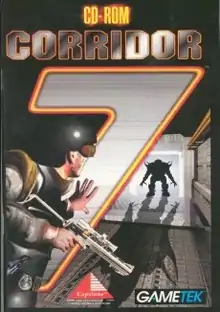Corridor 7: Alien Invasion
Corridor 7: Alien Invasion is a first-person shooter video game developed by Capstone Software and published by Intracorp and GameTek. It was widely ignored for its outdated Wolfenstein 3D engine, which was technologically surpassed by Doom at the time. A sequel, Corridor 8: Galactic Wars, was in development, but later cancelled.
| Corridor 7: Alien Invasion | |
|---|---|
 CD cover art | |
| Developer(s) | Capstone Software |
| Publisher(s) | IntraCorp GameTek |
| Engine | Modified Wolfenstein 3D engine |
| Platform(s) | MS-DOS |
| Release | March 1994 |
| Genre(s) | First-person shooter |
| Mode(s) | Single-player, Multiplayer |
Plot
A military facility called the Delta Base worked on experimental space technology. Their latest experiment called a dimensional gate (or the Vortex) led to the discovery of an alien world. However those hostile aliens went through the Vortex and overran the base and killed everyone within. A single soldier of the Special Forces, penetrates the base to kill the aliens and destroy the source of their power.
Gameplay

Corridor 7 consists of 30 floors (plus an additional 10 in the CD version) and 6 bonus floors. The player is tasked with killing a certain number of enemies before the exit to the next floor is accessible. There are four difficulty settings, which influences the percentage of aliens that need to be eliminated and how much damage the player will take from enemy attacks and traps. In the CD version, there is a fifth setting, which randomly scatters enemies and items throughout the game.
The player can activate the proximity map in one corner of the screen. This function shows a small section of the current level with all active aliens as yellow blips and can be expanded by finding the floor plan. The player is equipped with a visor capable of both infrared and night vision. Infrared is employed to detect invisible traps, while night vision is especially useful to better see when playing on dark levels. Ammunition and health are not scattered around the levels as objects to pick up, but rather as dispenser bays encased in the level walls. Health is also available in special rooms called "health chambers", where the player can obtain up to 100 hit points. There are two ammo types as well which power up human firearms and alien firearms respectively.
Locked areas do require a color-coded (blue or red) passcard to be opened. These cards are granted by operating special wall-sized computer terminals; since these terminals are also placed behind the color-coded doors. Some of the aliens names are common names re-arranged or backwards (e.g. the Tenaj is Janet backwards, and the Otrebor is Roberto backwards as well).
Multiplayer
The immense success of the multiplayer modes in Doom is probably the reason behind the addition of LAN and modem gameplay modes in the CD release of Corridor 7. The only multiplayer mode featured is deathmatch, and an extra set of 8 multiplayer maps is included. Players can deathmatch impersonating either the Special Forces soldiers from the single-player mode or as one of the aliens; playing as an alien results in possessing the distinctive abilities of the creature chosen (e.g. speed or endurance).
Sequel
Corridor 8: Galactic Wars, sometimes simply known as Corridor 8, was the planned sequel to Corridor 7. The game was in development and used the Build engine, though it was never finished because the developer, Capstone Software, went bankrupt along with their parent company, IntraCorp, in 1996. The game only made it to prototype stage. In 2005, Les Bird released the Corridor 8 prototype and source code to a Corridor 7 fan, who put it onto his website as a free download.[1]
References
- Steven M. Schafer, Corridor 7 Official guide - Brady publishing 1994
- Capstone Software archive Archived 2015-10-02 at the Wayback Machine on lesbird.com
- Anderson, Chris (July 1994). "PC Zone Review - Corridor 7". PC Zone. No. 16. Future plc. p. 63.
External links
- KBW's Corridor 7 Page Corridor 8 prototype and source code download
- Corridor 7: Alien Invasion at MobyGames